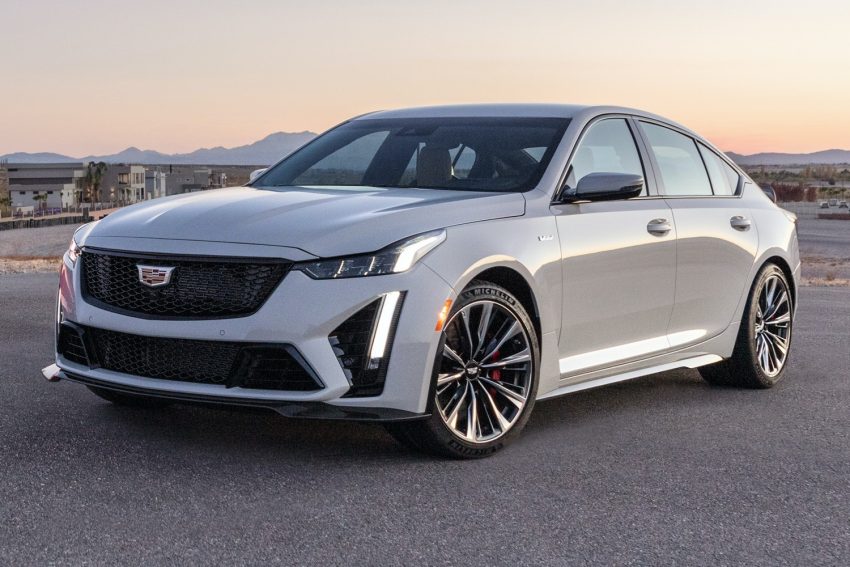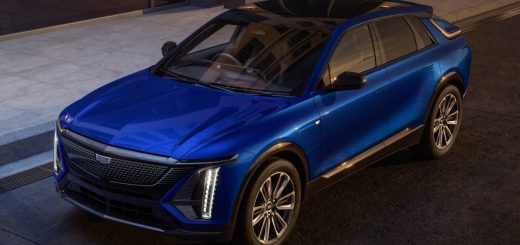The Environmental Protection Agency has released its official fuel economy estimates for the high performance 2022 Cadillac CT5-V Blackwing.
| Model | Transmission | City (mpg) | Highway (mpg) | Combined (mpg) |
|---|---|---|---|---|
| 2022 Cadillac CT5-V Blackwing | 6-speed manual | 13 | 21 | 15 |
| Model | Transmission | City (mpg) | Highway (mpg) | Combined (mpg) |
|---|---|---|---|---|
| 2022 Cadillac CT5-V Blackwing | 10-speed automatic | 13 | 22 | 16 |
| 2019 Cadillac CTS-V | 8-speed automatic | 14 | 21 | 16 |
Cadillac’s latest supercharged V8 performance sedan has an estimated fuel economy rating of 13 mpg city, 21 mpg highway and 15 mpg combined when equipped with the standard six-speed manual transmission. The available GM 10-speed automatic is slightly more efficient, carrying an EPA estimated rating of 13 mpg city, 22 mpg highway and 16 mpg combined. Based on these figures, the EPA predicts Cadillac CT5-V Blackwing owners will spend between $3,500 and $3,750 on fuel annually.
The 2022 Cadillac CT5-V Blackwing comes standard with a supercharged 6.2L V8 LT4 engine, which produces 668 horsepower and 659 pound-feet of torque. As we mentioned previously, the six-speed manual transmission comes standard, while the GM 10-speed automatic is available for a premium. Both transmissions route power exclusively to the rear wheels.
The 2022 Cadillac CT5-V Blackwing’s fuel economy numbers are comparable to its competition. The 2021 BMW M5 Competition, for example, is rated at 15 mpg city, 21 mpg highway and 17 mpg combined. The M5 packs a twin-turbocharged 4.4L V8 engine, which doles out 600 horsepower and 553 pound-feet of torque, and comes standard with an eight-speed automatic and all-wheel-drive. The 2021 Mercedes-AMG E63, meanwhile, is rated at 16 mpg city, 23 mpg highway and 18 mpg combined. Similar to the BMW, it comes with a twin-turbo 4.0L V8 pumping out 603 horsepower and 627-pound-feet of torque and comes standard with a nine-speed automatic and AWD.
Pricing for the 2022 Cadillac CT5-V Blackwing starts at $84,990, while the 10-speed automatic bumps that up to $88,165. Both of those prices exclude the tax, title, license, dealer fees, and optional equipment.
Production of the 2022 Cadillac CT5-V Blackwing will begin at the GM Lansing Grand River plant in Michigan on July 5th.
Be sure to subscribe to GM Authority for more Cadillac CT5-V Blackwing news, Cadillac Blackwing news, Cadillac news and ultra-high-performance GM news coverage.



















Comments
How far we’ve come…those numbers are better than the 205 horsepower 1984 Corvette, and competitive with 1985 and later TPI ‘Vettes (230-250 horsepower).
1984 Corvette with 4 spd. auto was rated at 16 city, 28 hwy, 20 combined. Regardless, what is the point in making any comparison between vehicles 38 model years apart? If you compared a 1984 Corvette with a vehicle 38 years earlier, that would be a 1946? There is no comparison.
Using the criteria the CT5-V is tested to, an 84 Corvette was rated 13/20/15; the 16/28/20 test standards you referenced went away in 2008. You can access the EPA’s database and see both labels.
The point of comparing the two 4.4″ o/c bore spacing, fuel-injected, pushrod V8’s is simple: It clearly demostrates that technology has delivered us from an era where a lightweight two seat sports car with only 205 hp could manage only 15 mpg to an era where an opulent four door sedan with over three times the power – 668 hp – can deliver better fuel economy, despite being able to literally run circles around the former. Similarly, a new Escalade will out-accelerate an 86/87 Buick Grand National, while achieving better fuel economy.
We’re living in an awesome period for car enthusiasts.
But the CT5-V (and or Escalade) would not deliver equal or better fuel economy with an equal transmission and other driveline components of that era. It was a different era completely. Bolt up a 4 spd. auto to one of these new vehicles and see what values you (or the EPA) arrive at? The same works the other way, use a modern 10 spd. auto behind the L83 engine and guess what, greatly improved fuel mileage! Materials and metals have advanced, tires, lubricants/oils and ECU/computer controls of that time were nothing compared to today. Again, there is no comparing? Why belittle or disparage 30+ year old vehicles/engines to prop up new ones?
On a side note…….a few folks today think that what was happening at Buick in 1987 was pretty special. An 8.7 mile, still in the wrapper, 1987 Buick GNX sold for………………………$250K+fees @ Barrett Jackson in LV on Sat. afternoon. I would would bet no CT5-V Blackwing will ever command that kind of coin?
Look at the prices for CTS-V Wagons, keeping in mind these aren’t prices from some fancy auction. I’d say low mileage CTS-V wagons are already there.
Bringing it full circle, the CT5-V Blackwing is today’s 1986-7 Grand National/WE4/GNX. Both glorious end-of-summer blasts with long, dark winters looming.
Who could’ve imagined then that the Grand National would have to keep the flame burning for Buick fans for 34 long, empty years and counting? Nevermind winter – Ice Age is more like it…
Let’s hope it’s not the swan song that the GN/GNX turned out to be. But with electrification on the horizon, it probably is.
I think it’s possible these could have gained significant collectible status down the road, if they would have followed thru with the actual Blackwing engine. gm blew millions developing that engine, then went cheap and back to the LT4. Very powerful for sure and already a proven commodity, but it’s been used in many thousands of Z06’s, CTS-V’s and ZL1’s.
I never cared for the attitude that JdN had while “running” Cadillac, but at least he was trying to elevate the brand and do something different?
That’s possible and I guess the CT6-V may quickly become collectible for its true Blackwing engine. I think using the Blackwing name on this car and even going from CTS to CT5 were all questionable.
But given GM is abandoning ICE vehicles, the small-block V8 is what GM has been doing so well, and it’s fitting that the last CT5-V use the small block. Too bad the CT4-V did not use an NA version, because the fuel economy advantage is not meaningful, but I digress again…
My prediction is the manual CT5-V will be the first to reach collectible status. Look no further than manual CTS-V wagons for sale now are fetching north of $60K
Uh, pretty sure all of the advancements you listed fall under that “technology” heading I referenced. I’m not “belittling or disparaging” those cars – I loved those cars, owned multiples of them back in the day, and still have a 9k mile example in one of my bays today. I’m simply – as I previously stated – drawing a contrast between the height of American performance (and associated economics) at the beginning of the electrified era to today…we’ve simultaneously more-than-tripled power output AND improved the economics…through technology.
Lastly, put an extra 1,500 lbs on the L83 C4, or 2,500 lbs on a GN – with or without the 10A – and see what happens to both their economy and performance.
The main result here is that it incurs a $6400 gas guzzler tax.
My 2009 CTS-V got 14/19… so I can tell everyone I’m upgrading for the highway fuel economy.
On my 16 CTS V I’ve gotten over 28 mpg cruising between 70-80mph. Not bad for a 640hp supercharged V8 sedan. Conditions must have been right because I haven’t been able to hit that again. But then again I didn’t buy this car for it’s gas mileage, so that’s a bonus.
After watching celebrities fly around the World in private jets telling me I am the cause of global warming, it has made me painfully aware that I need to increase my carbon footprint and this is going to be the machine to do it !!
So who is the brainless person that will buy a 15 mpg car, someone who owns one of the gas company’s? GM get a brain!
Buy a real vehicle that will leave the Cadillac in the dust Tesla Plaid. Hellooooo!
It all comes down to Soul. Either you got it or you ain’t. Obviously, you ain’t.
Isn’t the longitudinal 10-speed a Ford design from the collaboration? Ford did the longitudinal and GM did the transverse transaxle if i am not mistaken?
While they both may manufacture their own is it not disingenuous to call it a GM transmission when Ford designed it?
Yeah if i were to have one, this time i would take the auto.
Terrible fuel mileage but that shouldn’t be a major concern if you buy one. I love gasoline engines but there’s really been minimal progress in getting better economy from an internal combustion engine. I had a 98 Honda Accord V6 coupe that I kept for 15 years and I would get 25 mpg on the highway at 75 mph. My wife’s 2017 v6 Camry gets maybe 27 at the same speed. The 98 had a 4 speed auto vs 6 speed in the camry. See what I mean about ice engines and the fact that they’ve taken them about as far as is possible to extract better fuel economy. Granted the 98 accord with 200hp wasn’t as quick as the 268 hp Camry but it wasn’t a slouch either.
This car is the definition of a driver’s car indeed, hope to see this complete with other super sedans!